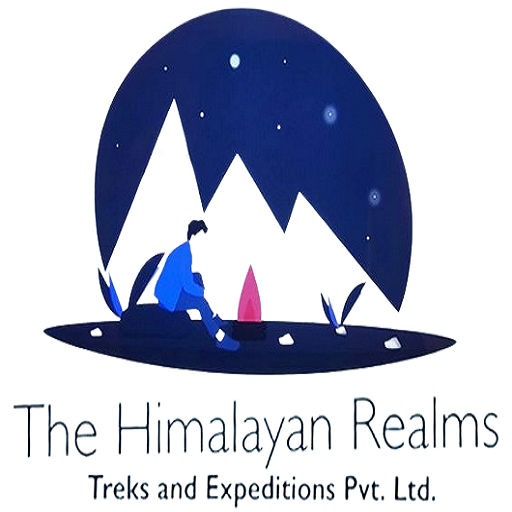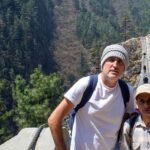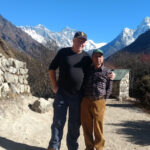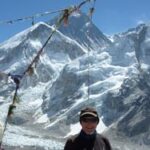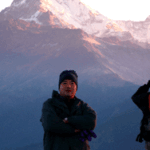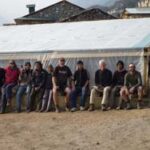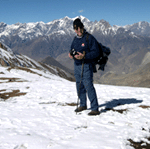Damodar kunda Lake overview
Damodar kunda, a sacred lake is located at an altitude of 4,890 meters (16,043 ft) in the remote Mustang region of Nepal. It is a significant pilgrimage site for Hindu and Buddhist devotees. According to Hindu mythology, it is believed that Lord Krishna recommended visiting Damodarkunda to cleanse sins. The lake is situated in the rain-shadow area of the Annapurna and Dhaulagiri ranges, offering breathtaking views of the snow-capped peaks, barren landscapes, and deep valleys.
Location:
The journey to Damodar Kunda Lake usually starts from Jomsom, initially following the classic Upper Mustang route through the restricted region. Along the way, trekkers pass through breathtaking landscapes, gradually ascending towards the remote and sacred lake. Moreover, as they progress, they encounter ancient Tibetan-influenced villages, centuries-old monasteries, and rugged terrains that add to the adventure. Eventually, after days of trekking through arid valleys and high-altitude trails, they reach the revered Damodar Kunda, a site of spiritual significance for Hindu and Buddhist pilgrims alike. Trekkers traverse through Kagbeni, Chele, Syangboche, Tsarang, and Lo Manthang, experiencing the ancient Tibetan culture, traditional villages, and stunning arid landscapes. Beyond Lo Manthang, the trail leads to the remote and less-traveled path towards Damodarkunda, where trekkers encounter high passes, rocky terrain, and the strong influence of Tibetan Buddhism.Religious History:
About the Religious of Damodar Kunda
Damodar Kunda Lake holds immense religious significance: Hindu Beliefs: The lake is believed to be the source of the Gandaki River, a holy river mentioned in Hindu scriptures. Bathing in the lake is said to wash away sins and bring salvation. Buddhist Beliefs: Tibetan Buddhists also revere the lake, considering it a sacred site associated with various deities and spiritual practices.
Cultural & Natural Significance
Until 1992, Upper Mustang was restricted to outsiders; as a result, its unique Tibetan-influenced culture remained well preserved. Moreover, the region was once an independent kingdom, ruled by a local king (Lo Gyalpo), and even today, it retains its historical monarchy. Furthermore, due to its isolation, the area boasts untouched landscapes, ancient cave dwellings, and centuries-old monasteries. Consequently, it remains a living museum of Tibetan heritage, offering visitors a rare glimpse into a way of life that has endured for centuries.
Highlights of Damodar Kunda & Upper Mustang
Damodar Kunda Lake (4,890m) – A sacred pilgrimage site for Hindus & Buddhists, believed to cleanse sins. Lo Manthang (3,840m) – The walled capital of the ancient Mustang Kingdom, home to royal palaces & monasteries. Ghar Gompa (8th century) – One of Nepal’s oldest monasteries, linked to Guru Rinpoche (Padmasambhava). Mysterious Sky Caves – Over 10,000 human-made caves, some containing ancient Buddhist manuscripts, mummies, and relics. Kagbeni & Muktinath – Spiritual landmarks offering both Buddhist and Hindu significance. Tibetan Culture & Festivals – Tiji Festival (celebrating the victory of good over evil) is a major cultural highlight. This trek is not just about adventure but also about experiencing a hidden, spiritual world untouched by modernity. The area remains a restricted zone, requiring a special permit to enter. The Tiji Festival, celebrated in Lo Manthang, is a major attraction, showcasing masked dances and rituals to ward off evil spirits.
Atmosphere at Damodar kunda Lake
Damodar kunda lake , situated at 4,890 meters (16,043 feet) in the remote Upper Mustang region, has a serene yet harsh atmosphere. The lake, surrounded by barren hills and rugged landscapes, offers a tranquil and spiritual ambiance. Due to its high-altitude location in the rain-shadow of the Himalayas, the climate remains cold and dry throughout the year.
The air at Damodar kunda Lake is thin and crisp, making breathing slightly challenging for those not acclimatized. Strong winds are common, especially in the afternoons, adding to the feeling of remoteness. The surrounding terrain is rocky and arid, with little vegetation, except for hardy alpine plants. Despite the barren environment, the lake’s crystal-clear blue waters contrast beautifully with the stark brown hills and distant snow-capped peaks of the Annapurna and Dhaulagiri ranges.
The Damodar Kunda lake spiritual energy at Damodarkunda is profound. Pilgrims and trekkers often describe a sense of peace and divine connection when visiting the lake. The silence of the area, interrupted only by the sound of the wind and the occasional chants of monks, enhances its mystical charm.
How to Reach: The journey to Damodar Kunda Lake typically begins from Kathmandu. Here’s a breakdown of the route: Kathmandu to Pokhara: Take a flight or bus from Kathmandu to Pokhara.Pokhara to Jomsom: Fly from Pokhara to Jomsom, the gateway to Upper Mustang. Jomsom to Kagbeni: Trek or take a jeep from Jomsom to Kagbeni, a village at the entrance of Upper Mustang. Kagbeni to Damodar Kunda: The trek usually takes several days, passing through picturesque landscapes and remote villages.
Important Considerations:
Required Permits for Damodar Kunda Trek
Restricted Area Permit (RAP) for Upper Mustang
Cost: USD 500 per person for the first 10 days, then USD 50 per day for each additional day. Issued by: Department of Immigration, Nepal
Can only be obtained through a registered trekking agency (like The Himalayan Realms Treks and Expedition Nepal Pvt. Ltd.).
Annapurna Conservation Area Permit (ACAP) Cost: NPR 3,000 (Approx. USD 25) per person Required as Upper Mustang lies within the Annapurna Conservation Area (ACA)
Trekkers’ Information Management System (TIMS) Card Cost: NPR 2,000 (Approx. USD 15) per person Helps keep track of trekkers for safety purposes. Since Upper Mustang is a restricted region, solo trekking is not allowed—you must be accompanied by a licensed guide.
Best Time to Visit
The ideal time to visit Damodar kunda LAKE & Upper Mustang is April to June and
The best time for this trek is from September to November, as the clear weather during these months offers breathtaking mountain views and ensures a pleasant journey. Additionally, the stable climate and mild temperatures enhance the overall trekking experience. Moreover, the post-monsoon freshness brings vibrant landscapes, making this season ideal for exploration and photography. Furthermore, the favorable conditions allow for safer and more comfortable trekking, with well-defined trails and minimal weather-related disruptions. Likewise, the crisp air and excellent visibility create perfect opportunities for capturing stunning scenery. In addition, this period sees fewer weather-related challenges, allowing trekkers to fully immerse themselves in the region’s natural beauty and cultural richness. Consequently, September to November remains the most recommended time for this unforgettable adventure. It’s a perfect choice for adventurers, spiritual travelers, and explorers looking to uncover Nepal’s hidden treasures and experience the magic of the Trans-Himalayan region.
Acclimatization & Altitude Sickness Prevention
Gradual Ascent: Avoid rapid altitude gain; take rest days if necessary. Hydration: Drink plenty of water to prevent dehydration. Avoid Alcohol & Smoking: These can worsen altitude sickness. Medication: Consider Diamox (Acetazolamide) after consulting a doctor. Listen to Your Body: If symptoms of AMS (Acute Mountain Sickness) appear, descend immediately.
Physical Fitness Preparation
Cardiovascular Training: Running, cycling, or swimming to improve endurance. Strength Training: Focus on legs, core, and upper body. Hiking Practice: Do multi-day hikes with a backpack to simulate trekking conditions.physical fitness.
Additional Information:
Damodar Kunda Lake is surrounded by stunning Himalayan peaks, offering breathtaking views.The region is rich in Tibetan culture, with ancient monasteries, traditional villages, and unique customs. Shaligrams, fossilized ammonites considered sacred by Hindus, are found in the area.
1. Luri Gompa
One of the oldest cave monasteries in Upper Mustang, famous for its ancient Buddhist murals and statues. Located near Yara village, it offers a great blend of spiritual and historical exploration.
2. Teri La Pass (5,595m)
A challenging high-altitude pass connecting Upper Mustang with Nar Phu Valley. Ideal for experienced trekkers seeking adventure and panoramic views of the Annapurna and Dhaulagiri ranges.
3. Lo Manthang (3,840m)
The walled capital of the former Kingdom of Mustang, rich in Tibetan Buddhist culture. Visit ancient monasteries, the royal palace, and explore the unique mud-brick architecture.
4. Yara & Ghara Villages
Traditional Tibetan-influenced villages with unique cave dwellings.A great cultural side trip offering interactions with local communities.
5. Muktinath (3,800m)
A significant pilgrimage site for both Hindus and Buddhists.Known for the eternal flame and 108 water spouts, believed to purify sins.
6. Saribung Peak (6,328m)
A challenging climbing option for mountaineers. The trek to Saribung Peak also connects to Nar Phu Valley, offering a unique circuit.
Planning Your Trip:
Research and choose a reputable trekking agency to organize your trip. Pack appropriate clothing and gear for varying weather conditions and high altitudes. Carry sufficient cash as there are limited banking facilities in Upper Mustang. Respect the local culture and customs.
Annapurna Region
Similarly, Himalayan Realms Treks offers a wide range of trekking routes in the Annapurna region, including both classic trails and off-the-beaten-path adventures. Moreover, these routes cater to trekkers of all skill levels, from beginners seeking a short and scenic trek to experienced hikers looking for a challenging expedition. In addition, the breathtaking landscapes, diverse cultural experiences, and well-established trekking infrastructure make the Annapurna region an ideal destination for adventurers. Below are some of them for your information.
Kathmandu Chitwan & Pokhara Tours 7/8 Days
Australian camp Tour Nepal for 6 days
Kathmandu,Pokhara and Sarangkot Tour (6 days)
Dhampus, Sarangkot Trek 8 days
Jomsom Muktinath Trek, 13 days
